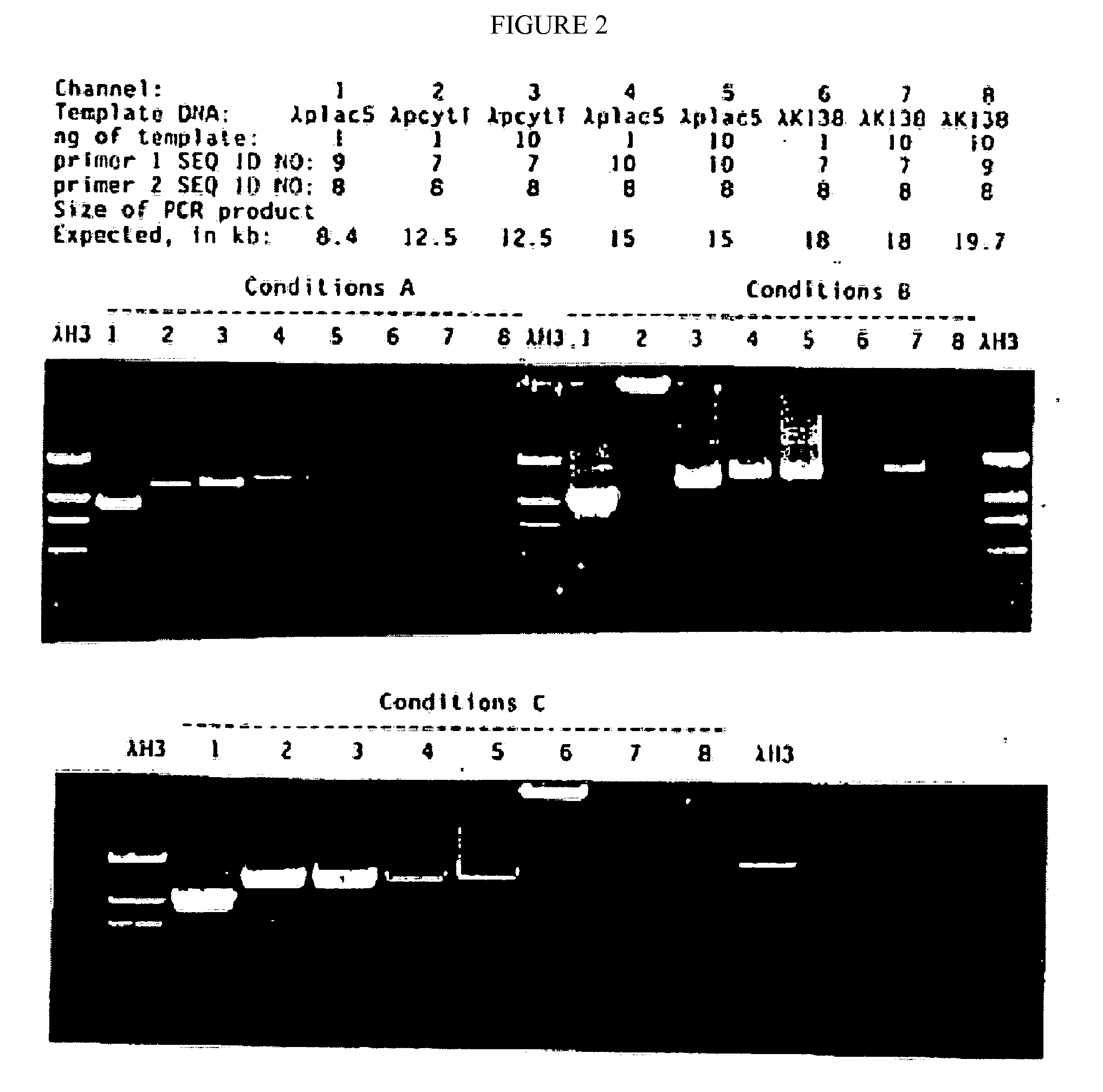DNA polymerases with enhanced length of primer extension
a technology of dna polymerases and primer extensions, which is applied in the field of dna polymerases, can solve the problems of ineffective but detectable amplification, inability to perform in the 10-15 kb size range of wt dna polymerase, and inability to maximize the yield of pcr target fragments, so as to enhance the intensity and sharpness of pcr product bands, reduce mutagenicity, and maximize the yield of pc target fragmen
- Summary
- Abstract
- Description
- Claims
- Application Information
AI Technical Summary
Benefits of technology
Problems solved by technology
Method used
Image
Examples
example 1
Construction of an Expressible Gene for Klentaq-278
[0089]In order to construct the Klentaq-278 DNA polymerase gene having a recombinant DNA sequence as described above, the following procedure was followed.
[0090]The mutated gene was amplified from 0.25 ug of total Thermus aquaticus DNA using the polymerase chain reaction (PCR, Saiki et al., Science 239:487, 1988) primed by the two synthetic DNA primers of Table 1. Primer KT1, SEQ ID NO:1, has homology to the wild-type DNA starting at codon 280; this primer is designed to incorporate a NcoI site into the product amplified DNA. Primer Klentaq32, SEQ ID NO:3, a 33 mer spanning the stop codon on the other strand of the wild-type gene encoding Thermus aquaticus DNA polymerase, and incorporating a HindIII site and a double stop codon into the product DNA. The buffer for the PCR reaction was 20 mM Tris HCl pH 8.55, 2.5 mM MgCl2, 16 mM (NH4)2SO4, 150 ug / ml BSA, and 200 uM each dNTP. The cycle parameters were 2′ 95° C., 2′ 65° C., 5′ 72° C.
[...
example 2
Preparation of an Expression Vector
[0092]The product NcoI and HindIII fragment was cloned into plasmid pWB254b which had been digested with NcoI, HindIII, and calf intestine alkaline phosphatase. The backbone of this plasmid, previously designated pTAC2 and obtained from J. Majors, carries the following elements in counter-clockwise direction from the PvuII site of pBR322 (an apostrophe ' designates that the direction of expression is clockwise instead of counter clockwise): a partial lacZ′ sequence, lacI′, lacPUV5 (orientation not known), two copies of the tac promoter from PL Biochemicals Pharmacia-LKB; catalog no. 27-4883), the T7 gene 10 promoter and start codon modified to consist of a NcoI site, a HindIII site, the trpA terminator (PL no. 27-4884-01), an M13 origin of replication, and the AmPR gene of pBR322. Expression of the cloned gene is expected to be induced by 0.1 mM IPTG.
[0093]Ampicillin-resistant colonies arising from the cloning were assayed by the single colony ther...
example 3
Purification of Large Amounts of Klentaq-278
[0094]Plasmid pWB254 has a double (tandem repeat) tac promoter and the T7 gene 10 leader sequence, an ATG start codon, a glycine codon and then codons 280-832 of Thermus aquaticus DNA polymerase, then a tandem pair of stop codons followed by the trp transcription terminator. The pBR322-based plasmid vector (pTac2 from John Majors) is ampicillin resistant. The cells are grown on very rich medium (see below). Bacterial host X7029 is wild-type F-E. coli except for deletion X74 of the lac operon.
[0095]Medium: Per liter water, 100 mg ticarcillin (added when cool), 10 g Y. E., 25 g. Tryptone, 10 g. glucose, 1XM9 salts with no NaCl (42 mMNa2PO4, 22 mM KH2PO4, 19 mM NH4Cl). Do not autoclave the glucose and the 10XM9 together; instead, autoclave one of them separately and mix in later. Adjust pH to 8 with 5 M NaOH (about 1 ml). Add IPTG to 0.1 mM at OD550=1 or 2, and shake well at 30° C. From OD=2 up to 8 or 10, every half hour or so do the followi...
PUM
| Property | Measurement | Unit |
|---|---|---|
| temperature | aaaaa | aaaaa |
| temperature | aaaaa | aaaaa |
| temperature | aaaaa | aaaaa |
Abstract
Description
Claims
Application Information
 Login to View More
Login to View More - R&D
- Intellectual Property
- Life Sciences
- Materials
- Tech Scout
- Unparalleled Data Quality
- Higher Quality Content
- 60% Fewer Hallucinations
Browse by: Latest US Patents, China's latest patents, Technical Efficacy Thesaurus, Application Domain, Technology Topic, Popular Technical Reports.
© 2025 PatSnap. All rights reserved.Legal|Privacy policy|Modern Slavery Act Transparency Statement|Sitemap|About US| Contact US: help@patsnap.com



